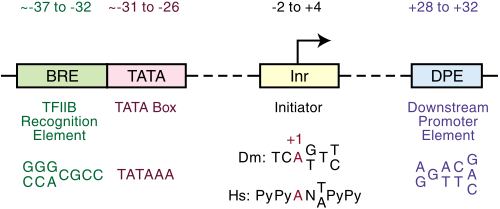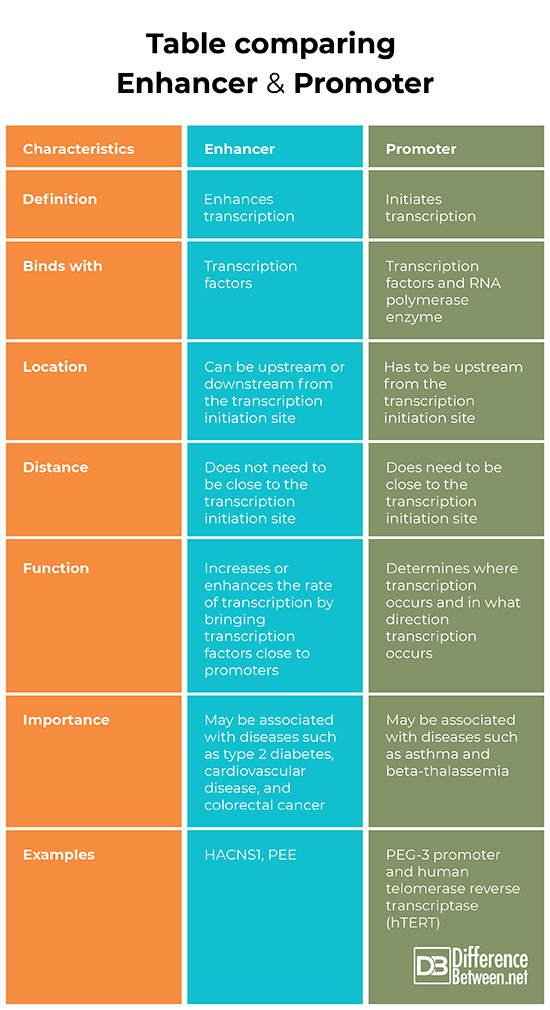Difference Between Enhancer and Promoter
What is Enhancer?
Definition of Enhancer:
An enhancer is a short piece or sequence of DNA that works to enhance or speed up the rate of genetic transcription. An enhancer is also often called a cis-regulatory element and is between 20 to 400 base pairs of DNA in size.
Location:
An enhancer can be located either upstream or downstream of a particular gene and can be in either the same or a different orientation compared with the gene to be transcribed. An enhancer does not need to be close to the initiation site of transcription in order to function. Enhancers are present and function in both prokaryotic cells and in eukaryotic cells. Enhancers can be found on introns and exons and can act on the genes of a different chromosome.
Function:
A transcription factor attaches to the enhancer to help stimulate the transcription of the gene. Enhancers, in fact, do not act directly on promoters but have to first be attached to transcription factors. Enhancers can be thousands of bases away from a transcription initiation site. This is possible because of how enhancers function. Transcription factors first bind to an enhancer. Then a DNA bending protein brings the enhancer closer to the promoter in a process known as DNA looping. Enhancers thus enhance or speed up the rate of transcription by bringing transcription actors closer to the promoter. Enhancers can also regulate more than one gene regardless of their orientation relative to the genes or genes. Enhancers also are an important genetic element in development since they can help to enhance the activation of transcription in cells.
Importance:
Certain enhancers may play a role in human disease and research suggests that cis-regulators may indeed increase the risk of diseases such as type 2 diabetes, cardiovascular disease, and colorectal cancer.
Examples of Enhancer:
An example of a gene enhancer that was discovered is HACNS1, which is thought to have had a role in the evolution of the human thumb. Another example of an enhancer is the proximal epiblast enhancer (PEE), which is an important enhancer during the development of the vertebrate body.
What is Promoter?
Definition of Promoter:
Promoters are pieces of DNA sequences that indicate where transcription of DNA by RNA polymerase starts. Promoters are involved in initiating or starting genetic transcription since they determine which DNA strand will be transcribed (i.e. which strand is the sense strand), and in which direction the transcription will occur.
Location:
Promoters are usually found upstream from the start of transcription at the 5’end of where transcription starts. Promoters have to be in a 5’position near to the gene to be transcribed. The 5’end of DNA refers to the DNA strand that ends on a 5’carbon. Promoters are found in both prokaryotic cells and eukaryotic cells.
Function:
The promoters bind to both the RNA polymerase enzyme and to transcription factors.The promoter initiates the process of transcription by interacting with RNA polymerase and transcription factors. The RNA polymerase enzyme weakly binds to a DNA sequence and moves along the strand until it encounters a promoter. At this stage, it then forms a closed promoter complex with the promoter. The RNA polymerase then proceeds to unwind the DNA at the transcription initiation or start site to form an open promoter complex. Transcription is then initiated.
Importance:
Certain genetic promoters may be implicated and involved in diseases. Variations in promoters may be associated with certain diseases such as beta-thalassemia and asthma.
Examples of Promoter:
Many eukaryotic cells have an important part of the promoter known as the TATA box, which can be found from 25 to 35 bases upstream from the starting point of transcription. Several examples of promoters have been discovered. Some of these are important in the development of cancer. For instance, the PEG-3 promoter and human telomerase reverse transcriptase (hTERT), which are both found in cancer cells.
Difference between Enhancer and Promoter?
-
Definition
An enhancer is a piece of DNA that enhances gene transcription. A promoter is a piece of DNA which acts to initiate or start gene transcription.
-
Binds with
An enhancer binds with transcription factors while a promoter binds with transcription factors and RNA polymerase enzyme.
-
Location
An enhancer can be upstream or downstream from the site where transcription is initiated while a promoter is always upstream from the site where transcription is initiated.
-
Distance
An enhancer does not need to be close to the site where transcription is initiated while a promoter does have to be close to the site where transcription is initiated.
-
Function
An enhancer works to enhance or increase transcription while a promoter works to initiate the transcription process.
-
Importance
Enhancers are thought to be associated with diseases such as type 2 diabetes, cardiovascular disease, and colorectal cancer. Promoters are thought to be associated with diseases such as asthma and beta-thalassemia
-
Examples
Examples of enhancers include HACNS1 and PEE. Examples of promoters are the PEG-3 promoter and human telomerase reverse transcriptase (hTERT).
Table comparing Enhancer and Promoter
Summary of Enhancer Vs. Promoter
- An enhancer is a sequence of DNA that functions to enhance transcription.
- A promoter is a sequence of DNA that initiates the process of transcription.
- A promoter has to be close to the gene that is being transcribed while an enhancer does not need to be close to the gene of interest.
- Both promoters and enhancers help to regulate genetic transcription.
- Enhancers and promoters can be important in disease.
- Difference Between Rumination and Regurgitation - June 13, 2024
- Difference Between Pyelectasis and Hydronephrosis - June 4, 2024
- Difference Between Cellulitis and Erysipelas - June 1, 2024
Search DifferenceBetween.net :
1 Comment
Leave a Response
References :
[0]Image credit: https://upload.wikimedia.org/wikipedia/commons/thumb/0/01/Core_promoter_elements.svg/500px-Core_promoter_elements.svg.png
[1]Image credit: https://upload.wikimedia.org/wikipedia/commons/thumb/1/12/Gene_enhancer.svg/500px-Gene_enhancer.svg.png
[2]Gagniuc, Paul, and Constantin Ionescu-Tirgoviste. "Eukaryotic genomes may exhibit up to 10 generic classes of gene promoters." BMC genomics 13.1 (2012): 512.
[3]Kulaeva, Olga I., et al. "Distant activation of transcription: mechanisms of enhancer action." Molecular and cellular biology (2012): MCB-01127.
[4]Pennacchio, Len A., et al. "Enhancers: five essential questions." Nature Reviews Genetics 14.4 (2013): 288.




I know there isn’t enhancer in prokaryotes…?